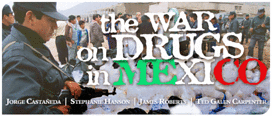In his essay, James Roberts argues that Mexico blames the United States for its drug-related violence, when in reality the corruption of Mexican elites and narco-traffickers cooperating with the Venezuelan government are at fault. While corruption in the Mexican state has hindered a more robust response to drug-related violence, and the rise of Venezuela as a transit country for narcotics is concerning, neither is to blame for Mexico becoming the transit point for 90 percent of the cocaine that enters the United States. For that, much of the blame lies with the United States — for both its failure to curb cocaine production in Colombia and its failure to curb demand for cocaine, marijuana, heroin, and meth at home.
Roberts suggests that the United States should up its assistance to Mexico along the lines of the Merida Initiative, but with more funding. He seems to believe that such a policy would work, because, after all, the model for the Merida Initiative, the United States’ $6 billion counternarcotics program in Colombia, was “successful.” Plan Colombia may have increased security for some of Colombia’s citizens, but from a counternarcotics standpoint, it was a failure. It certainly didn’t decrease the amount of cocaine being produced in Colombia. According to the UN Office on Drugs and Crime [pdf], Colombia produced 617 metric tons of cocaine in 2001, and 610 metric tons of cocaine in 2007. Plan Colombia’s stated goal was to reduce production by 50 percent in six years. The UN’s statistics are corroborated by the research of the International Crisis Group in its March 2008 report on drugs in Latin America, Losing the Fight [pdf], as well as reports [pdf] from think tanks such as the Center for International Policy and the Washington Office on Latin America. The United States is currently negotiating an expanded military presence in Colombia – a presence that wouldn’t be necessary if Plan Colombia had been a true success.
Given that the United States’ best attempt to curb cocaine production was a $6 billion failure, it seems highly unlikely that a similar approach would lead to success in Mexico. As drug traffickers have shown time and time again, when efforts are made to disrupt their business, they adapt-whether by shipping their product to Europe via West Africa, or to Mexico via ship instead of air. Trying to disrupt the supply or transit of drugs is, as Ted Galen Carpenter clearly outlines, a futile endeavor.

